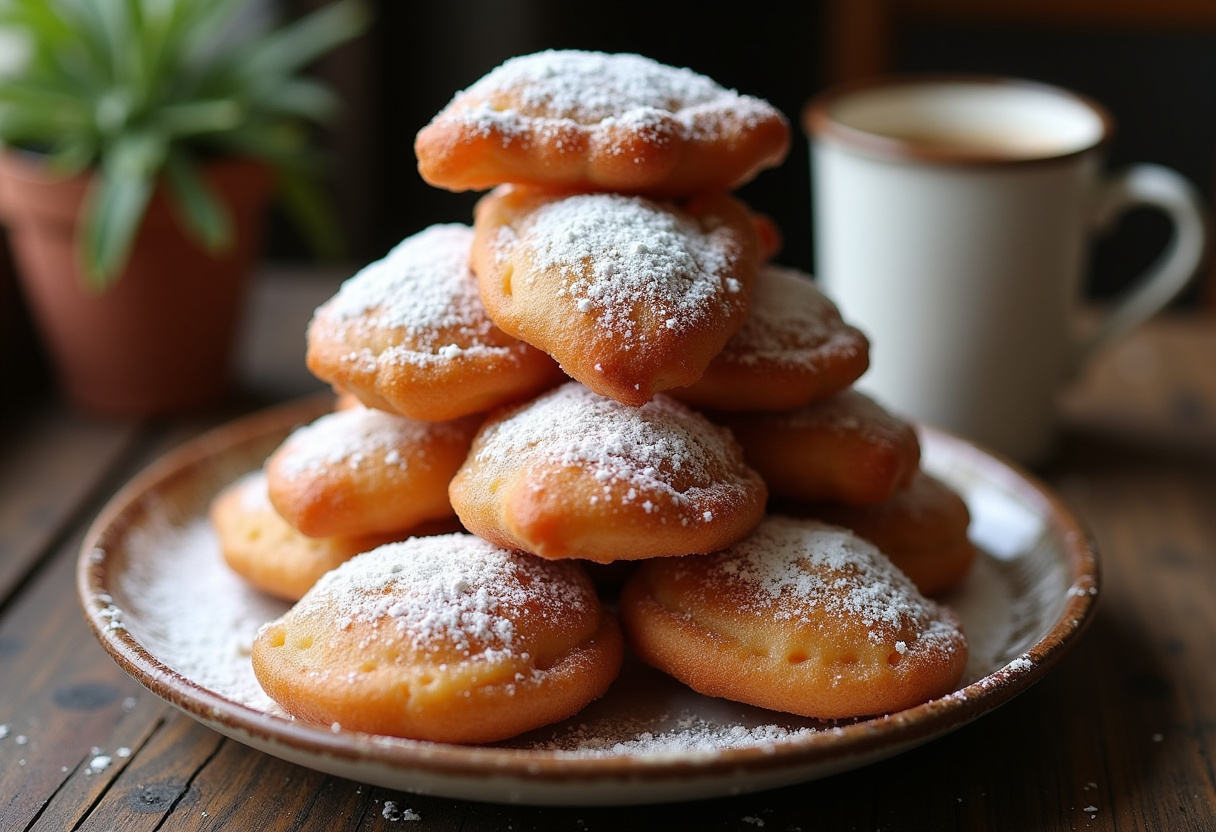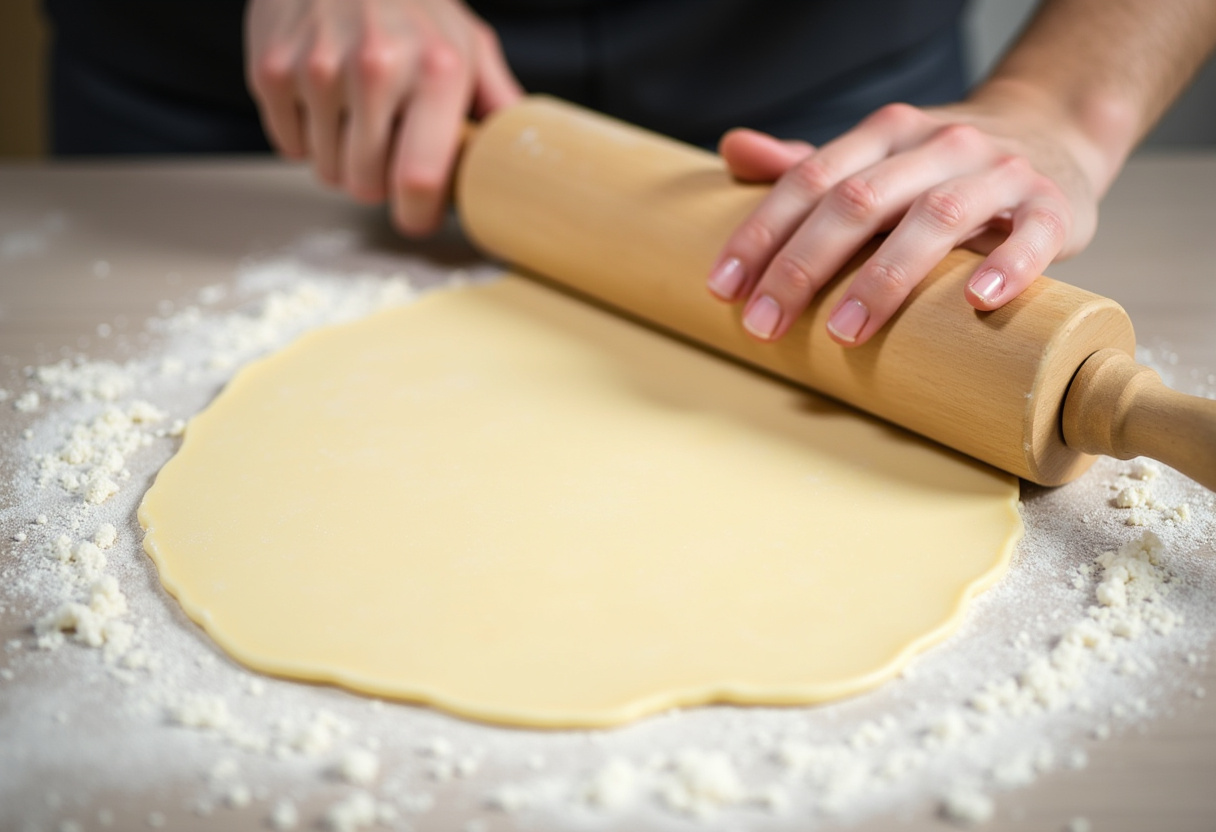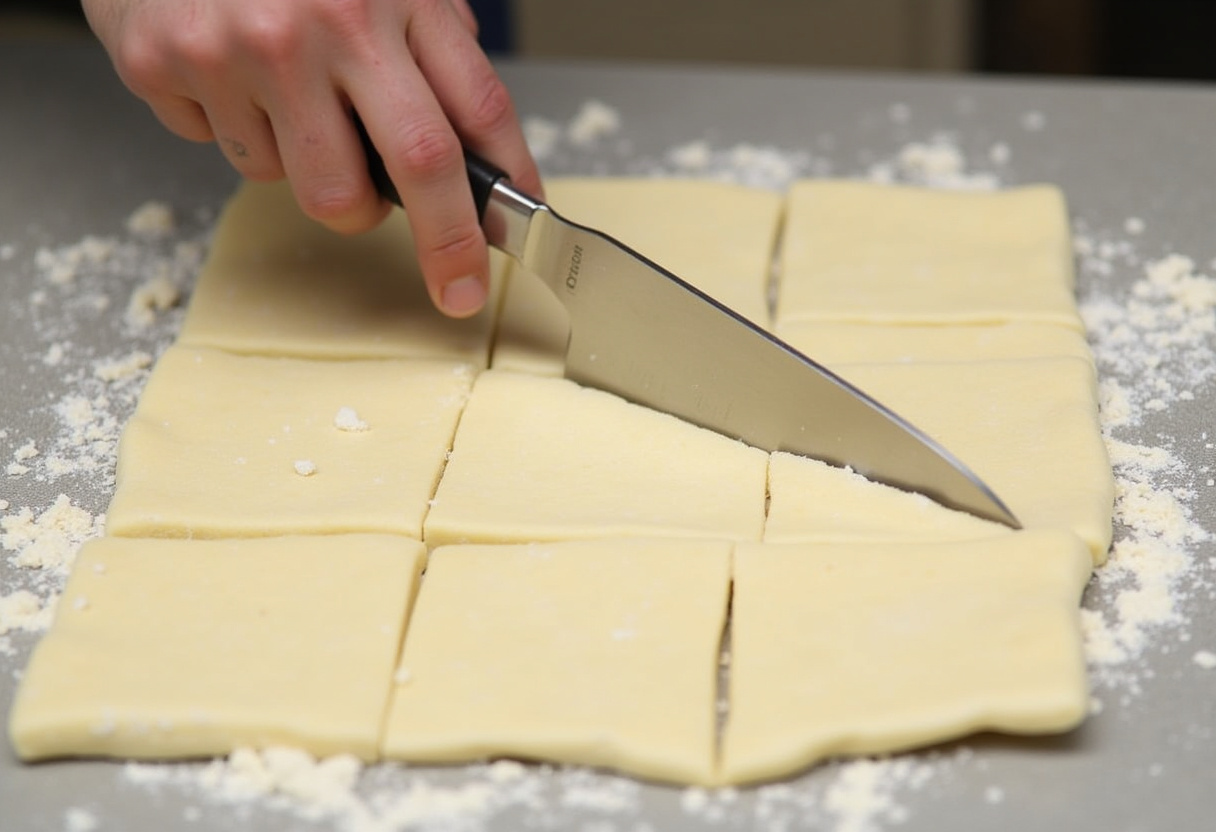Vanilla French Beignets: Irresistibly Fluffy, Golden, and Aromatic Delights 🍩✨☕
1. Introduction
Vanilla French Beignets are more than just a pastry – they’re a little bite of Parisian heaven that transforms any ordinary morning into something special. These pillowy-soft, golden-fried doughnuts infused with fragrant vanilla and generously dusted with powdered sugar have been delighting food lovers for centuries. Originating from French culinary traditions, beignets have become a beloved treat worldwide, especially when paired with a steaming cup of coffee or hot chocolate.
What makes this vanilla French beignets recipe so magical is its perfect balance of simplicity and elegance. While they might look fancy, these delicate pastries are surprisingly easy to make at home. Whether you’re planning a cozy weekend breakfast or need an impressive dessert for guests, these beignets will never disappoint. The aroma of vanilla and freshly fried dough wafting through your kitchen is enough to make anyone’s mouth water!

2. Ingredients
Gathering high-quality ingredients is the first step to perfect vanilla French beignets. Here’s what you’ll need:
- 2 ¼ tsp active dry yeast (1 packet): The leavening agent that gives beignets their signature airy texture
- ¾ cup warm milk (110°F): Whole milk works best for richness, but you can substitute with 2% if needed
- ¼ cup granulated sugar: For just the right amount of sweetness
- 1 large egg, room temperature: Helps bind the ingredients and adds richness
- 2 tbsp unsalted butter, melted: For tenderness and flavor
- 1 tsp pure vanilla extract: The star ingredient that gives these beignets their distinctive aroma
- ½ tsp salt: Balances the sweetness and enhances all the flavors
- 3 cups all-purpose flour, plus extra for dusting: The foundation of your dough
- Vegetable oil, for frying: Use a neutral oil with high smoke point like canola or peanut oil
- Powdered sugar, for dusting: The classic finishing touch
Pro Tip: For an extra special touch, try using vanilla bean paste instead of extract – you’ll see those beautiful vanilla specks throughout your beignets! If you love vanilla flavors, you might also enjoy our Limoncello Spritz recipe which uses similar aromatic principles.
3. Step-by-Step Instructions
Step 1: Prepare the Vanilla Dough
Begin by activating your yeast – this is crucial for getting that perfect rise. In a large mixing bowl, dissolve the yeast in warm milk (about 110°F – think baby bottle temperature) and let it sit for 5 minutes until it becomes frothy. This froth indicates your yeast is alive and active. If you don’t see bubbles after 5 minutes, your yeast might be too old and you’ll need to start fresh.
Once your yeast is activated, add the sugar, egg, melted butter, vanilla extract, and salt. Whisk these together until well combined. Now comes the flour – add it gradually, about 1 cup at a time, stirring with a wooden spoon or dough hook attachment if using a stand mixer. The dough will start to come together and pull away from the sides of the bowl.
Turn the dough out onto a lightly floured surface and knead for about 5 minutes. You’ll know it’s ready when it becomes smooth, elastic, and springs back when gently pressed. If you’re new to working with yeast doughs, don’t worry – this is much easier than it sounds! The kneading process develops the gluten which gives beignets their wonderful chew.

Step 2: Let the Dough Rise
Place your beautiful vanilla-scented dough in a lightly greased bowl (a quick swipe of butter or oil will do), turning it once to coat all sides. This prevents sticking and helps create an ideal environment for rising. Cover the bowl with a clean kitchen towel or plastic wrap and let it rest in a warm, draft-free spot.
The ideal rising time is 1-2 hours, or until the dough has doubled in size. If your kitchen is cool, you can create a warm spot by placing the bowl in an oven that’s been turned off but was briefly warmed to about 100°F (then turned off). The rising process is magical – those yeast cells are producing carbon dioxide bubbles that will make your beignets light and airy.
While you wait for the dough to rise, why not check out some of our other delicious recipes like this Mexican Mac and Cheese for later in the day?

Step 3: Shape the Beignets
Once your dough has doubled (it should look puffy and beautiful), gently punch it down to release the air bubbles. Turn it out onto a lightly floured surface and roll it to about ½-inch thickness – think the thickness of your finger. Using a sharp knife or pizza cutter, cut the dough into 2-inch squares. Don’t worry about being too precise – rustic beignets have their own charm!
As you cut the squares, transfer them to a lightly floured baking sheet, leaving about an inch between each piece. Cover them loosely with a clean kitchen towel and let them rest for about 10 minutes. This second rise, called proofing, allows the gluten to relax and gives the yeast one last boost before frying.
While your beignets are proofing, you can prepare your frying station. You’ll need a heavy-bottomed pot (like a Dutch oven), a slotted spoon or spider strainer, and a wire rack or paper towel-lined plate for draining. If you’re interested in other fried delights, our Copycat Chicken Bryan is another crowd-pleaser!

Step 4: Fry to Golden Perfection
Now for the exciting part – frying! Pour vegetable oil into your heavy-bottomed pot to a depth of about 2-3 inches. Heat the oil over medium heat until it reaches 350°F (175°C). A candy or deep-fry thermometer is invaluable here, but if you don’t have one, you can test the oil by dropping in a small piece of dough – it should bubble vigorously and rise to the surface.
Working in batches of 3-4 beignets at a time (don’t overcrowd the pot), carefully slide the squares into the hot oil. They’ll sink at first, then float to the surface. Fry for about 1-2 minutes per side, using your slotted spoon to gently flip them when the underside is golden brown. The beignets will puff up beautifully as they cook.
When both sides are a deep golden brown (think the color of honey), remove them to drain on paper towels or a wire rack. While they’re still warm but not piping hot, generously dust them with powdered sugar. For an extra special presentation, you can use a fine-mesh sieve to evenly distribute the sugar.
For more inspiration on perfect frying techniques, check out this comprehensive beignet guide from our friends at Preppy Kitchen.

4. Tips for Perfect Vanilla French Beignets
- Yeast freshness matters: Always check the expiration date on your yeast. Old yeast won’t give you the rise you need for fluffy beignets.
- Temperature control is key: Too hot and your beignets will burn outside before cooking through; too cool and they’ll absorb too much oil. Maintain that 350°F sweet spot.
- Don’t skip the resting times: Both the initial rise and the 10-minute proof after shaping are essential for texture.
- Work in batches: Frying too many at once lowers the oil temperature and leads to greasy beignets.
- Drain properly: Let them drain on a wire rack rather than paper towels to prevent sogginess on one side.
- Get creative with flavors: Add a pinch of cinnamon or nutmeg to the dough, or try citrus zest for variation.
5. Serving Suggestions
The classic way to enjoy vanilla French beignets is fresh and warm, piled high on a plate with plenty of extra powdered sugar for dusting. Serve them with:
- A steaming cup of café au lait (half coffee, half steamed milk)
- Rich hot chocolate with whipped cream
- Fresh berries and crème anglaise for an elegant dessert
- A drizzle of chocolate or caramel sauce for extra indulgence
- A scoop of vanilla ice cream for beignet à la mode
They also make a wonderful addition to a brunch spread alongside other morning favorites. If you’re planning a full dinner party, these beignets make a spectacular finale to your meal.
6. Storage and Reheating
While beignets are absolutely best enjoyed fresh, you can store leftovers in an airtight container at room temperature for up to 2 days. To reheat:
- Oven method: Place on a baking sheet and warm at 350°F for 5 minutes
- Air fryer method: 300°F for 3-4 minutes restores some crispiness
- Microwave (last resort): 10-15 seconds, but they may become chewy
For longer storage, you can freeze the unfried dough squares between layers of parchment paper in an airtight container for up to 3 months. Thaw in the refrigerator overnight, then proof at room temperature for 30 minutes before frying.
7. Variations
Once you’ve mastered the basic vanilla French beignet recipe, try these delicious variations:
- Chocolate-Stuffed Beignets: Place a small piece of high-quality chocolate in the center of each square before frying
- Fruit-Filled: Add a teaspoon of jam or fruit compote before sealing and frying
- Savory Twist: Reduce sugar to 1 tbsp and add herbs like rosemary or thyme for an unexpected appetizer
- Spiced: Add ½ tsp cinnamon, nutmeg, or pumpkin pie spice to the dough
- Glazed: Dip cooled beignets in a simple glaze made of powdered sugar and milk
If you enjoy experimenting with flavors, you might also love our Potato Chip Toffee recipe for another unique sweet-and-salty combination.
8. Frequently Asked Questions
Q: Can I make the dough ahead of time?
A: Absolutely! You can prepare the dough through the first rise, then punch it down, cover tightly, and refrigerate overnight. The cold fermentation actually develops more flavor. The next day, let it come to room temperature before rolling and cutting.
Q: Can I bake instead of fry?
A: While traditional beignets are fried, you can bake them at 375°F for 12-15 minutes. They won’t have quite the same texture, but will still be delicious. Brush with melted butter before baking for better browning.
Q: My beignets are dense. What went wrong?
A: This usually means your yeast wasn’t active enough, your rising environment wasn’t warm enough, or you didn’t let the dough rise long enough. Also, be careful not to add too much flour when kneading.
Q: Can I use instant yeast instead of active dry?
A: Yes! Use the same amount but you can mix it directly with the flour rather than proofing it in liquid first.
Q: How do I know when the oil is ready?
A: The ideal temperature is 350°F. Without a thermometer, the handle of a wooden spoon will bubble vigorously when dipped in oil at the right temperature.
9. Conclusion
Mastering this vanilla French beignets recipe will make you the star of any breakfast, brunch, or dessert table. There’s something truly magical about biting into a warm, fluffy beignet with that perfect balance of crisp exterior and tender interior, all perfumed with vanilla and coated in snowy powdered sugar.
Remember, like any yeast dough, beignets require a little patience but reward you with spectacular results. Don’t be intimidated – even imperfect homemade beignets taste amazing! We’d love to hear about your beignet-making adventures – share your photos and stories with us on social media.
For more delicious recipes and cooking inspiration, visit our About Me page to learn about our culinary journey. And as always, please review our Disclaimer and Terms and Conditions for using our recipes.
Happy cooking, and may your kitchen always be filled with the wonderful aroma of vanilla French beignets!
Print
Vanilla French Beignets Recipe
- Total Time: 30 minutes (plus rising time)
Description
Vanilla French Beignets are light, airy, and golden-fried doughnuts infused with aromatic vanilla and dusted with powdered sugar. This easy recipe brings café-style elegance to your breakfast or dessert table, perfect with coffee or as a sweet snack.
Ingredients
- 2 ¼ tsp active dry yeast (1 packet)
- ¾ cup warm milk (110°F)
- ¼ cup granulated sugar
- 1 large egg, room temperature
- 2 tbsp unsalted butter, melted
- 1 tsp pure vanilla extract
- ½ tsp salt
- 3 cups all-purpose flour, plus extra for dusting
- Vegetable oil, for frying
- Powdered sugar, for dusting
Instructions
- In a large bowl, dissolve yeast in warm milk and let sit for 5 minutes until frothy. Add sugar, egg, melted butter, vanilla extract, and salt, then mix well.
- Gradually add flour, stirring until a soft dough forms. Knead on a floured surface for 5 minutes until smooth.
- Place dough in a greased bowl, cover, and let rise for 1–2 hours until doubled in size.
- Roll dough to ½-inch thickness, cut into 2-inch squares, and let rest for 10 minutes.
- Heat oil to 350°F (175°C) and fry beignets in batches for 1–2 minutes per side until golden brown.
- Drain on paper towels and dust generously with powdered sugar while warm.
Notes
- Use fresh yeast for the best rise.
- Maintain consistent oil temperature for even frying.
- Fry in small batches to avoid overcrowding.
- Add cinnamon to powdered sugar for extra flavor.
- Prep Time: 15 minutes
- Cook Time: 15 minutes
Nutrition
- Serving Size: 1 beignet
- Calories: 120 Kcal
- Sugar: 6g
- Sodium: 60mg
- Fat: 4g
- Saturated Fat: 1.5g
- Unsaturated Fat: 2g
- Trans Fat: 0g
- Carbohydrates: 18g
- Fiber: 0.5g
- Protein: 2g
- Cholesterol: 15mg
Keywords: vanilla French beignets, homemade beignets, French doughnuts, vanilla pastry, fried desserts, easy beignet recipe





No comment